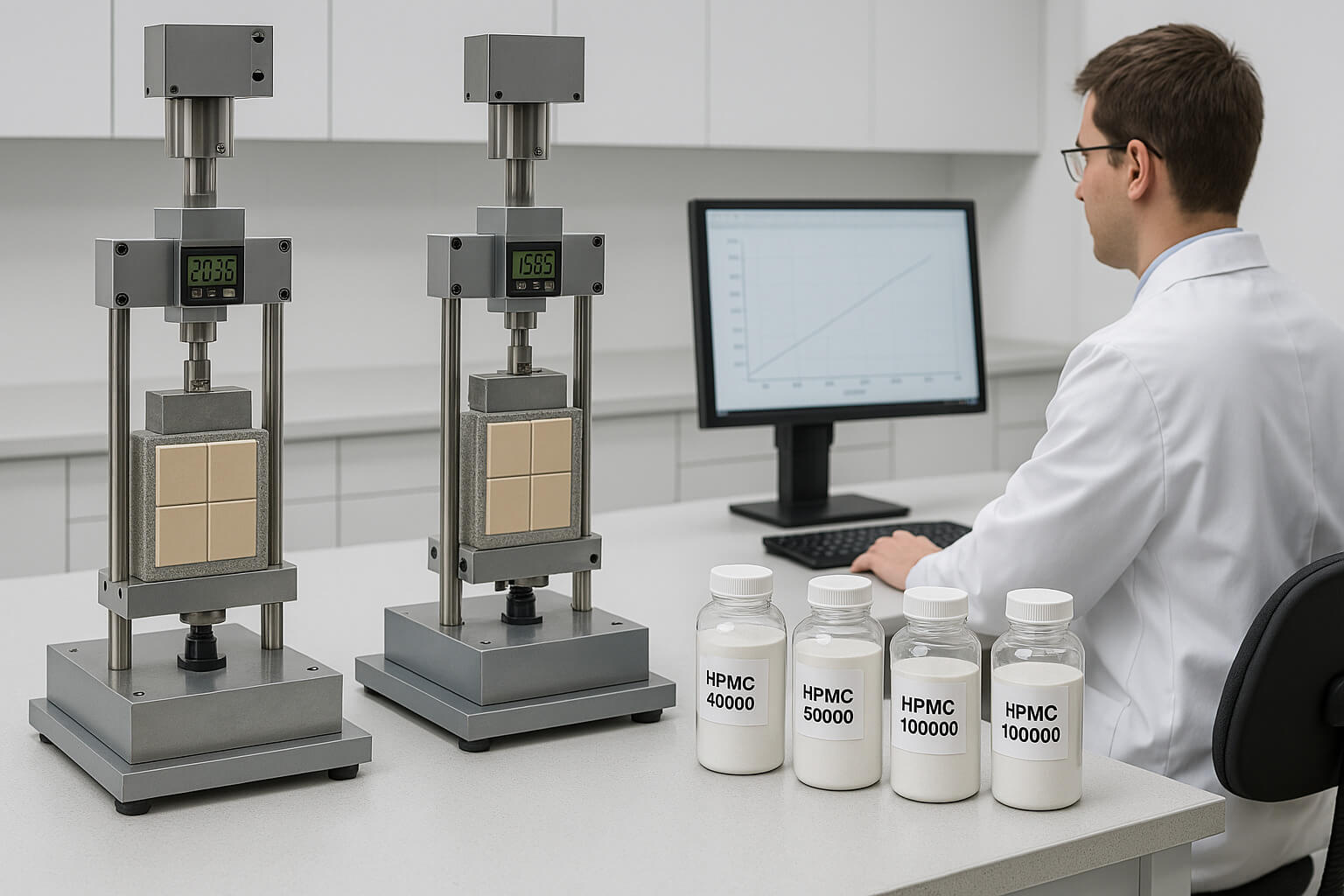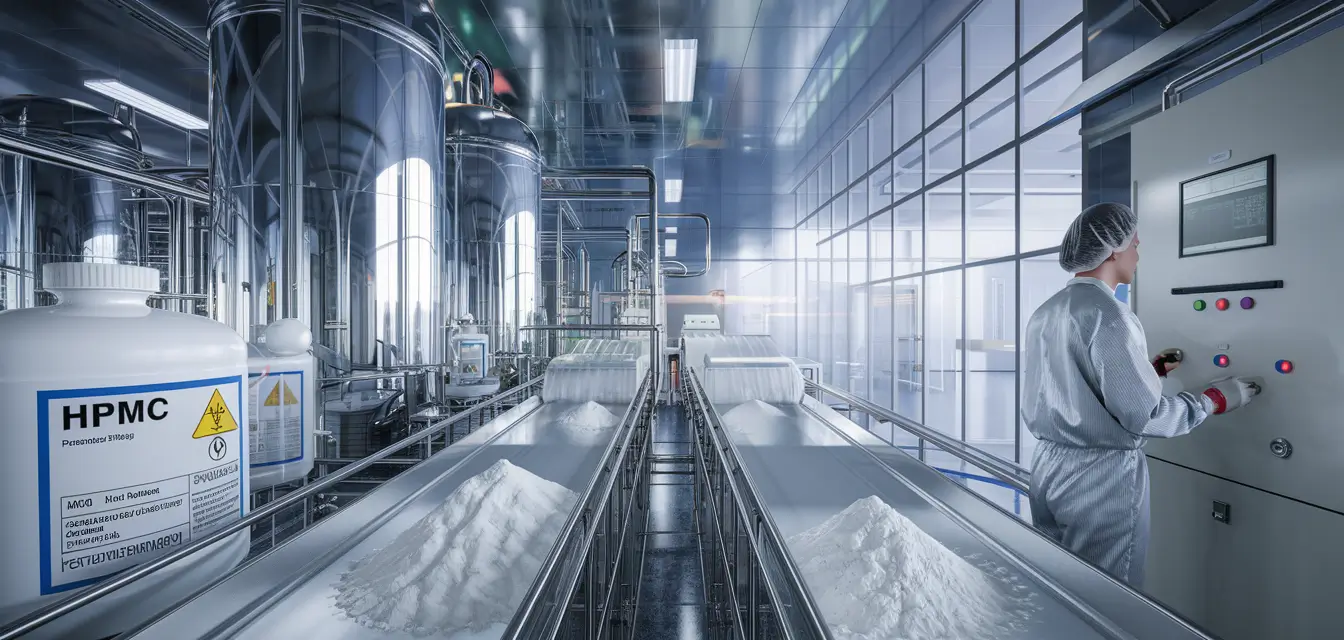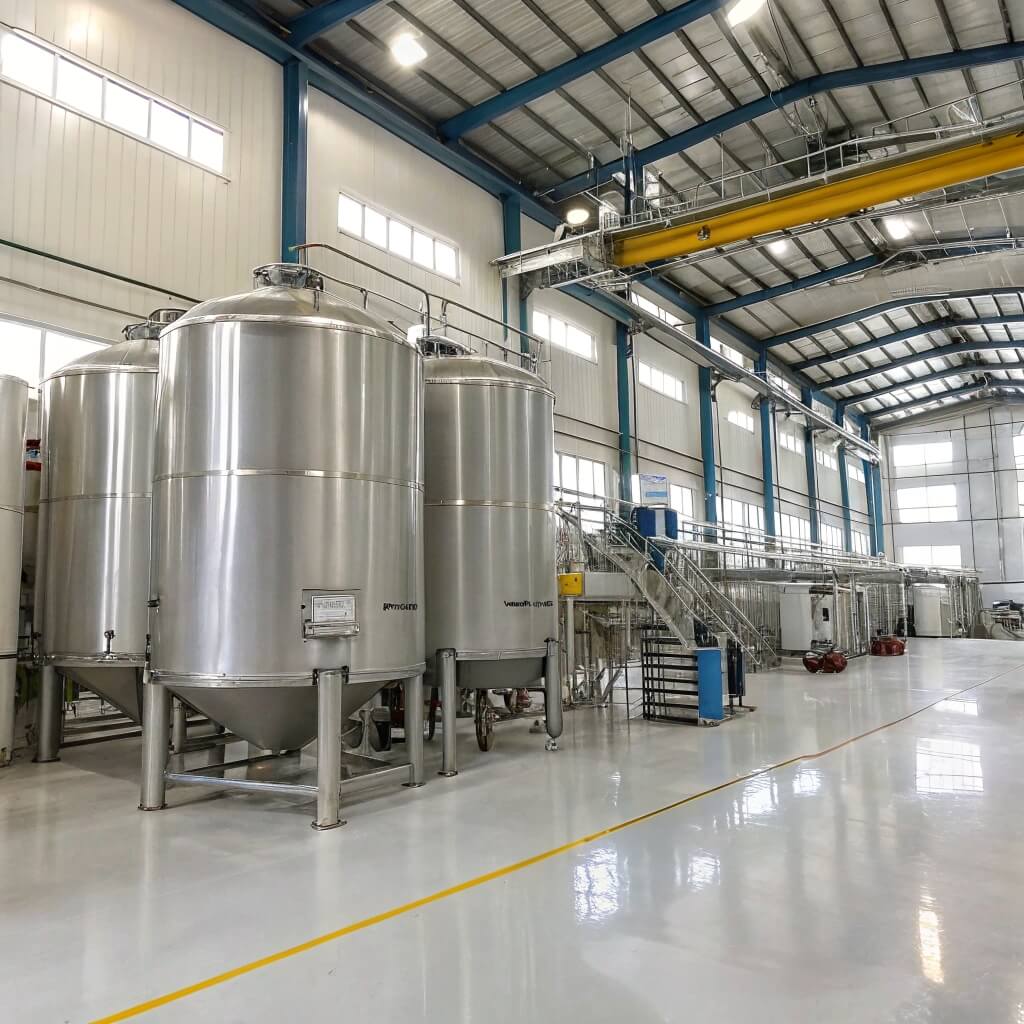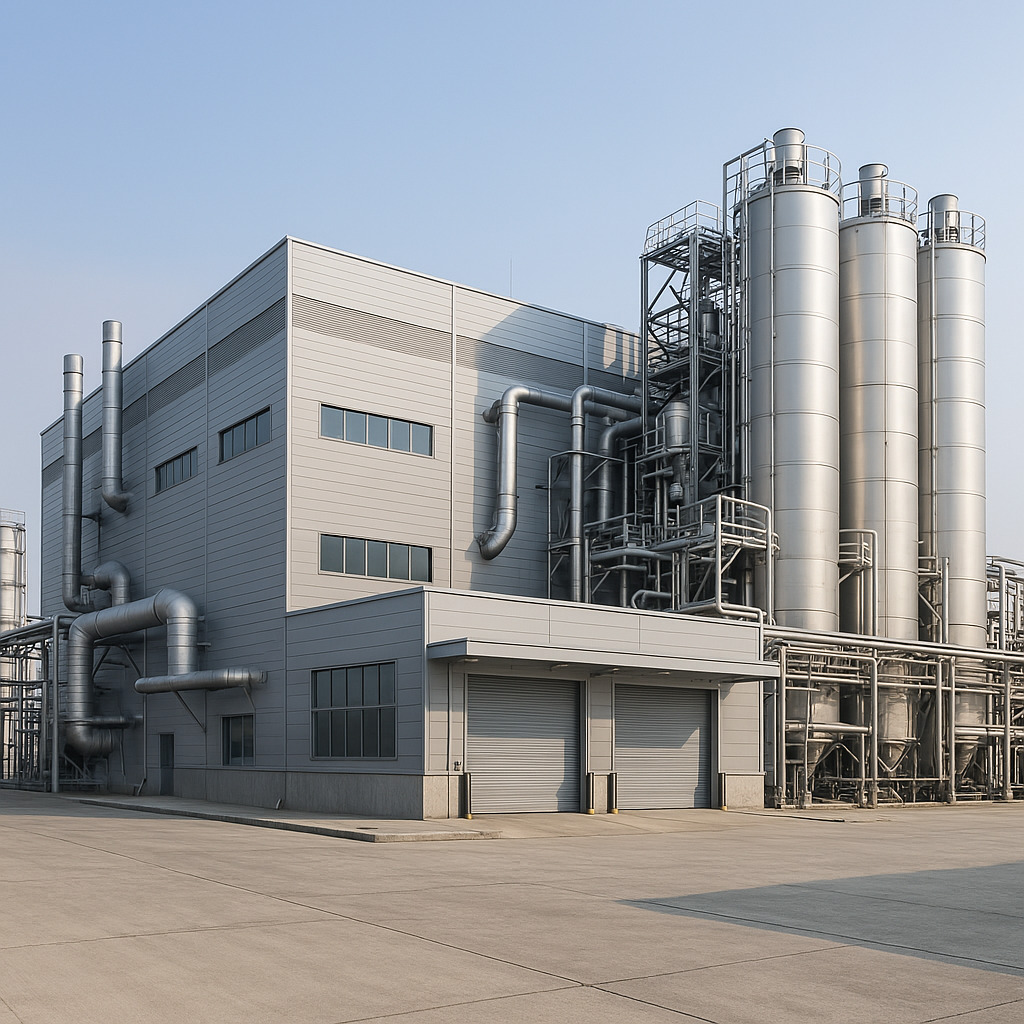Inconsistent tile adhesive performance causing project delays? Your HPMC viscosity might be the hidden culprit undermining bond strength and workability.
HPMC viscosity directly impacts cement adhesive strength by controlling water retention, open time, and sag resistance. The right viscosity grade ensures optimal mortar consistency, adhesion performance, and bond durability while maintaining workability for installers.

Laboratory testing of different HPMC viscosity grades and their effect on cement adhesive bond strength, showing samples under stress testing
Selecting the proper HPMC viscosity remains crucial for manufacturers seeking consistent adhesive performance. Let’s explore the relationship between these factors and how they affect your final product quality.
What is the relationship between HPMC and tile adhesive bonding?
Watching perfectly installed tiles fail unexpectedly? Poor water retention from incorrect HPMC selection commonly destroys adhesion performance within days of installation.
HPMC (Hydroxypropyl Methylcellulose) serves as a critical rheology modifier and water retention agent in cement-based tile adhesives. It creates a molecular network that holds water within the cement matrix during curing, allowing proper hydration of cement particles even on porous substrates.
Key bonding mechanisms of HPMC in tile adhesives
The primary ways HPMC enhances adhesive bonding derive from its unique molecular structure and interaction with cement particles. Our laboratory testing consistently demonstrates that HPMC molecules form hydrogen bonds with both cement components and substrate surfaces, creating a three-dimensional network that bridges the gap between materials. This network strengthens as water evaporates, producing robust mechanical interlocking between the adhesive and surrounding surfaces. We’ve observed that this process significantly improves both wet adhesion during application and long-term bond durability after curing completes.
- HPMC improves water retention by forming hydrogen bonds with water molecules
- The polymer chains create a three-dimensional network that enhances adhesion
- HPMC prevents premature moisture loss, ensuring complete cement hydration
- Controlled rheology provides better contact between adhesive and substrate
- Extended open time allows for proper tile adjustment before setting
- Reduced slump improves vertical application performance
Through our factory testing protocols, we’ve consistently found that the relationship between HPMC and bonding strength follows specific performance patterns identified in recent research. These patterns show that optimal molecular weight distribution directly correlates with superior adhesion performance across varied installation conditions.
How does HPMC viscosity affect cement adhesive strength?
Struggling with inconsistent bond strength between batches? Variations in HPMC viscosity often cause unpredictable adhesive performance that frustrates contractors and damages manufacturer reputations.
HPMC viscosity directly influences water retention capability, which determines how effectively cement particles hydrate during the critical curing period. Higher viscosity grades generally provide better water retention, preventing premature drying that would otherwise interrupt the cement hydration process.
When we produce HPMC for tile adhesives, we carefully control viscosity through molecular weight distribution and substitution patterns. Our production teams have observed that viscosity affects adhesive strength through multiple mechanisms. First, it determines how water distributes throughout the mortar during mixing and application. Second, it controls the polymer’s ability to form hydrogen bonds with cement particles and substrate surfaces. Third, it regulates open time by maintaining optimal moisture levels during installation.
Through extensive testing in our laboratories, we’ve found that viscosity directly correlates with several key performance parameters. Adhesives made with higher viscosity HPMC (typically above 20,000 mPa·s) retain moisture longer, allowing cement to develop stronger crystalline structures through complete hydration. This results in measurably higher tensile adhesion strength after curing, often exceeding industry standards defined by ISO 13007 by 15-30%.
However, viscosity must be precisely balanced. Extremely high viscosity can reduce workability and make the adhesive difficult to spread, potentially causing poor substrate wetting and reduced contact area. Our technical team has determined that optimal adhesive performance typically requires HPMC with viscosity ranges tailored to specific application requirements and regional climate conditions.
What happens when viscosity is too high or too low?
Found your tile adhesive becoming unworkable or runny within minutes? Incorrect HPMC viscosity disrupts installation timing and jeopardizes long-term adhesion performance at the jobsite.
HPMC viscosity that falls outside optimal ranges creates distinct performance problems that impact both application and final bond strength. Understanding these issues helps manufacturers troubleshoot adhesive formulations and adjust HPMC specifications accordingly.
When viscosity is too low, we observe several immediate consequences during production and application testing. The adhesive mixture fails to retain sufficient water, leading to rapid drying—especially on porous substrates. This premature moisture loss interrupts cement hydration, preventing proper crystal formation and ultimately weakening the adhesive bond. Our field testing shows that low-viscosity formulations typically exhibit reduced open time, making tile placement and adjustment difficult for installers. The adhesive also tends to slump excessively on vertical surfaces, defeating the anti-sag properties required for wall tile installations.
Conversely, excessive viscosity creates different challenges. While water retention improves, the mixture becomes increasingly difficult to mix thoroughly. This results in poor homogeneity and potential dry spots within the adhesive. Application becomes labor-intensive as the adhesive resists smooth spreading, leading to inadequate substrate coverage and inconsistent adhesive bed thickness. During our quality control testing, we consistently find that overly high viscosity can trap air bubbles within the mixture, creating weak points in the cured adhesive layer where bond failure may initiate under stress.
According to research published by RILEM on cementitious adhesives, the sweet spot for most tile installation environments requires balanced viscosity that provides 2-4 hours of workable time while maintaining sufficient body for proper ridging and contact area development.
How can you select the right viscosity grade for tile adhesives?
Confused by conflicting viscosity recommendations from different suppliers? Understanding application-specific requirements helps pinpoint the ideal HPMC viscosity for consistent jobsite performance.
Selecting the appropriate HPMC viscosity grade requires careful consideration of multiple factors including application environment, substrate properties, and installation requirements. The right choice balances water retention with workability to optimize adhesive strength.
When we consult with customers on viscosity selection, our technical team begins by analyzing installation conditions and performance requirements. For standard residential floor tile installations on moderately porous substrates, medium viscosity HPMC (15,000-30,000 mPa·s) typically provides optimal balance between water retention and workability. These grades maintain sufficient moisture for proper cement hydration while allowing easy troweling and ridge formation.
For more demanding applications like large-format tile or natural stone installation, higher viscosity grades (30,000-50,000 mPa·s) often prove necessary. These products provide enhanced water retention that compensates for the longer installation time required for precise placement of large tiles. Similarly, vertical applications benefit from higher viscosity to prevent slump while maintaining open time.
Climate conditions significantly impact viscosity requirements. In hot, dry environments, water evaporates more rapidly, necessitating higher viscosity grades to maintain adequate moisture levels. Conversely, cold or humid conditions may allow for lower viscosity while still achieving proper hydration. Our technical support team works with manufacturers globally to adjust formulations based on regional climate data analysis that correlates performance metrics with environmental factors.
Substrate porosity represents another critical consideration. Highly absorbent surfaces like unprimed concrete or certain masonry materials rapidly draw moisture from the adhesive. In these scenarios, we recommend higher viscosity HPMC to counteract moisture loss. Less porous substrates like existing tile or certain waterproofing membranes require more moderate viscosity to prevent excessive open time that could delay final setting.
How do formulation and mix design impact adhesive strength?
Experiencing inconsistent performance despite using the same HPMC grade? Formulation variables beyond viscosity often interact in unexpected ways, affecting final adhesive strength and performance reliability.
Formulation components and mix design significantly influence how HPMC viscosity translates to final adhesive strength. The interaction between HPMC and other ingredients creates a complex system where each component affects overall performance.
In our manufacturing experience, the cement-to-aggregate ratio fundamentally impacts how HPMC viscosity influences final bond strength. Higher cement content typically increases water demand, requiring careful adjustment of HPMC dosage and viscosity to maintain proper water retention without compromising workability. Through systematic testing in our R&D facilities, we’ve determined that HPMC effectiveness varies with cement type and fineness. Portland cement with higher C3A content tends to react more aggressively with water, benefiting from slightly higher viscosity HPMC to moderate the reaction rate and extend working time.
The presence of other additives significantly influences optimal HPMC viscosity selection. Redispersible polymer powders (RPPs) work synergistically with HPMC, enhancing flexibility and adhesion. However, they also modify water demand and rheology, sometimes requiring adjustment of HPMC viscosity to maintain balanced performance. Our formulation scientists have observed that latex-modified systems generally benefit from slightly lower HPMC viscosity grades compared to standard cementitious adhesives, as the latex contributes to water retention and provides additional binding capacity.
Mix water quality and temperature cannot be overlooked. Water hardness affects HPMC dissolution and performance, while temperature influences dissolution rate and initial viscosity development. In warm climates, where our products frequently ship, manufacturers sometimes need to adjust formulations to account for temperature effects on cement hydration kinetics and HPMC dissolution behavior.
Sand gradation and morphology also play critical roles in determining optimal viscosity. Angular aggregates increase internal friction within the mixture, potentially requiring lower viscosity HPMC to maintain workability. Conversely, rounded aggregates may flow too easily without sufficient viscosity to provide body and prevent slumping.
What innovations exist in HPMC for tile adhesives?
Frustrated by performance limitations in extreme conditions? Recent HPMC innovations address specific challenges that conventional grades struggle to overcome in demanding installation environments.
The HPMC market has evolved significantly, with new products specifically engineered to enhance cement adhesive performance beyond basic water retention. These innovations address evolving industry needs for faster installation, greater durability, and improved sustainability.
Before exploring these innovations, it’s important to understand their context within the broader evolution of tile installation systems. Traditional HPMC grades served primarily as water retention agents, with viscosity as the main performance parameter. Modern construction demands more sophisticated performance profiles that address multiple challenges simultaneously, from faster setting times to enhanced flexibility.
| Innovation Type | Primary Benefit | Viscosity Impact | Application Area |
|---|---|---|---|
| Modified Substitution Patterns | Enhanced temperature stability | Maintains consistent viscosity across temperature ranges | Exterior installations, seasonal applications |
| Dual-Function HPMC | Combined water retention and workability enhancement | Lower dosage achieves equivalent viscosity | Cost-effective standard mortars |
| Rapid-Dissolving Grades | Faster mixing, reduced air entrainment | Quicker viscosity development | Fast-track construction, machine application |
| Delayed-Action Formulations | Extended open time without compromising set | Initial higher viscosity that gradually reduces | Large format tile installation |
| Low-Dust Variants | Improved workplace safety | Equivalent viscosity with reduced airborne particles | Interior renovations, sensitive environments |
Our research laboratories have developed specialized HPMC variants with modified substitution patterns that provide temperature-stable viscosity profiles. Unlike conventional grades whose performance varies significantly with ambient temperature, these products maintain consistent water retention across a wider temperature range. This innovation has proven particularly valuable for exterior applications where installation conditions fluctuate throughout the day.
We’ve also introduced rapid-dissolving HPMC grades that dramatically reduce mixing time while minimizing air entrainment. These products achieve target viscosity much faster than traditional grades, allowing for quicker preparation and application. Field testing with professional installers confirms these products improve productivity while maintaining adhesion performance standards across various tile types and sizes.
Perhaps most significant for sustainable construction practices, our newest generation of HPMC includes products that achieve equivalent water retention and viscosity at lower dosage rates. This reduces the overall polymer content in formulations while maintaining performance, supporting green building initiatives that emphasize minimal chemical additives.
FAQs
What is the viscosity of HPMC?
HPMC viscosity typically ranges from 3,000 to 100,000 mPa·s (millipascal-seconds), measured in 2% aqueous solution at 20°C. The viscosity varies based on molecular weight and substitution pattern. Lower viscosity grades (3,000-15,000 mPa·s) offer good workability for general-purpose adhesives, while higher viscosity grades (30,000-100,000 mPa·s) provide enhanced water retention for demanding applications with extended open time requirements.
What is the use of HPMC in concrete?
In concrete applications, HPMC primarily serves as a water retention agent, preventing rapid moisture loss during curing. It also functions as a rheology modifier, improving workability, reducing segregation, and enhancing pumpability. HPMC increases cohesion in fresh concrete mixtures, reducing bleeding and improving finish quality. Additionally, it extends working time, enhances adhesion to substrates, and improves resistance to washout in underwater applications.
What is the viscosity of HPMC K100M and HPMC K15M?
HPMC K100M typically exhibits viscosity between 80,000-120,000 mPa·s (measured in 2% solution at 20°C), making it one of the highest viscosity grades available for construction applications. In contrast, HPMC K15M offers moderate viscosity between 15,000-25,000 mPa·s under the same measurement conditions. The K-series designation relates to the product’s specific substitution pattern and molecular weight distribution, with higher numbers indicating greater viscosity.
What is the difference between HPMC E5 and E15?
HPMC E5 and E15 differ primarily in viscosity and molecular weight. E5 provides lower viscosity (4,000-6,000 mPa·s in 2% solution at 20°C) suitable for sprayable mortars and self-leveling compounds where flow is critical. E15 offers medium viscosity (15,000-20,000 mPa·s) ideal for standard tile adhesives balancing workability with water retention. The "E" designation indicates a specific methoxyl and hydroxypropyl substitution pattern optimized for construction applications.
Conclusion
HPMC viscosity plays a crucial role in determining cement adhesive strength and overall performance. The right viscosity grade balances water retention, workability, and adhesion to deliver consistent results across various application conditions.
Through our decades of manufacturing experience, we’ve observed that optimal adhesive strength results from matching HPMC viscosity to specific project requirements. For standard interior applications, medium viscosity grades (15,000-30,000 mPa·s) typically provide the best balance of properties. More demanding installations may require higher viscosity products to extend open time and enhance water retention.
Successful formulation requires considering multiple factors beyond viscosity alone, including cement type, aggregate quality, and additive interactions. Our technical team at Morton is available to provide personalized recommendations for your specific application needs. Contact us today for a consultation on selecting the optimal HPMC grade for your cement adhesive formulations.




